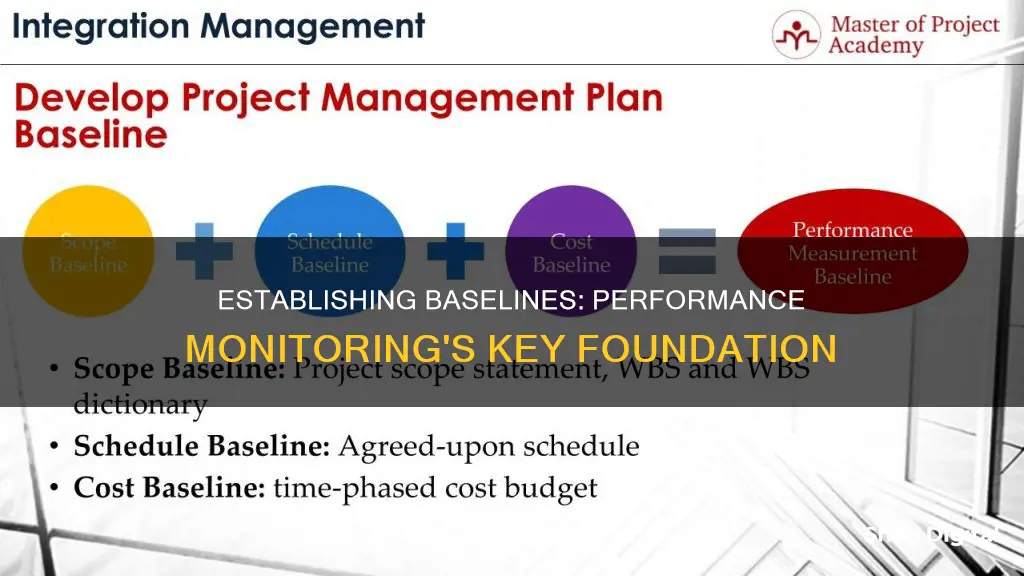
Baselines are important for monitoring performance as they provide a reference point to measure progress and performance. In the context of project management, a baseline is a predefined and approved plan that acts as a benchmark. It helps project managers track deviations, make necessary adjustments, and keep projects on track. Baselines also ensure that all stakeholders have a common understanding of the project's objectives, deliverables, and constraints, minimising confusion and helping to align the team towards shared goals.
In IT, a baseline is the status quo, or norm, from which abnormal behaviour is detected and improvements are measured. It is essential for effective monitoring and detecting abnormal activity. Similarly, in network monitoring, a baseline provides a clear picture of the network's normal functioning, allowing for the identification of problems and anomalies.
Baselines are also important in scientific research and monitoring, providing initial data and a reference point for future comparisons. Overall, establishing a baseline is crucial for effective monitoring and performance evaluation, providing a clear understanding of the current situation and a reference point for measuring progress and identifying areas of improvement.
What You'll Learn
- Baselines help to identify the current situation, gaps and guide the development of interventions
- Baselines are a reference point to measure progress and evaluate performance
- Baselines help to establish indicators to track progress towards achieving desired outcomes
- Baselines are necessary to accurately measure the impact of an intervention
- Baselines provide data to measure the effectiveness of an intervention

Baselines help to identify the current situation, gaps and guide the development of interventions
Baselines are essential for monitoring performance as they provide a clear picture of the current situation and help identify gaps. By establishing a baseline, we can gather data on the present status, attitudes, and behaviours of the target population or project parameters. This data serves as a reference point to track progress and evaluate the impact of interventions or projects.
In the context of IT-managed services, for example, a baseline is the norm from which abnormal behaviour is detected. It helps in monitoring network activity, spotting trouble spots, and optimising performance. Similarly, in project management, a baseline is a predetermined set of measurements, plans, and targets against which actual progress and performance are measured. It includes scope, schedule, cost, and quality parameters, providing a framework to assess deviations and make necessary adjustments.
Baselines are also crucial in fields like environmental monitoring, where baseline data on air quality, noise levels, soil conditions, hydrology, and biodiversity is collected to identify potential impact areas and inform management decisions. In addition, baselines are used in healthcare to establish monitoring parameters for specific conditions, such as the impact of acorn production on tick populations and the risk of Lyme disease.
Overall, establishing a baseline is vital for identifying the current situation, understanding gaps, and guiding the development of interventions. It provides a reference point to measure progress, evaluate success, and make informed decisions to keep projects on track and achieve desired outcomes.
Monitoring Memory Usage in IIS: A Comprehensive Guide
You may want to see also

Baselines are a reference point to measure progress and evaluate performance
Baselines are an essential component of monitoring and evaluating the performance of any project. They provide a reference point to measure progress and evaluate performance by establishing a clear starting point.
A baseline is a predetermined and approved plan that captures the initial scope, schedule, cost, and quality parameters of a project. It is a benchmark that allows project managers to track and assess deviations, make necessary adjustments, and keep the project on track. The baseline serves as a point of comparison to identify whether the project is progressing as planned or requires corrective actions.
For example, in IT-managed services, a baseline is established by monitoring network activity and identifying the expected range of website traffic, electrical power consumption, and network packets sent and received by servers. This baseline helps detect abnormal activity and optimize performance. Similarly, in project management, a baseline includes the scope, schedule, cost, and quality baselines, providing a comprehensive framework to manage the project effectively.
Baselines are also crucial in fields like mineral exploration, where baseline monitoring assesses environmental, economic, and social issues to identify potential impact areas during mining operations. In ecological studies, baseline monitoring helps track trends in biological variables and ecosystem functioning over time.
Overall, establishing a baseline is essential for effective performance measurement, stakeholder alignment, decision-making, risk management, and objective evaluation in various fields and projects.
Ultimate Guide to Buying a 1440p Monitor: What You Need to Know
You may want to see also

Baselines help to establish indicators to track progress towards achieving desired outcomes
Baselines are an essential component of monitoring and evaluating the performance of any project. They provide a reference point to measure and evaluate progress, and a clear understanding of the current situation. Baselines are particularly important when it comes to tracking progress towards achieving desired outcomes.
A baseline study is an initial assessment conducted before the implementation of an intervention or project. It involves gathering data on the current situation, attitudes, and behaviours of the target population. This data becomes the reference point from which progress can be measured and evaluated.
For example, in IT-managed services, a baseline is established by monitoring network activity and watching for trouble spots. This baseline then becomes the norm from which all abnormal behaviour is detected, and improvements can be measured against it. Similarly, in project management, a baseline is a predefined set of measurements, plans, and targets against which the actual progress and performance of a project are measured and monitored. It acts as a benchmark, allowing project managers to identify deviations, make necessary adjustments, and keep projects on track.
Baselines help establish indicators that track progress towards achieving desired outcomes by providing a clear picture of the current state. This can include hardware and software configurations, initial scope, schedule, cost, and quality parameters, as well as risk assessments. By establishing these indicators, project managers can effectively monitor and control project progress, ensuring that projects stay on track and meet their objectives.
In summary, baselines are crucial for monitoring performance as they provide a reference point and a clear understanding of the current situation. They help establish indicators that track progress, allowing for the identification of deviations and the implementation of necessary adjustments. By establishing a baseline, projects can be kept on track and desired outcomes can be achieved.
Performance Monitoring: What Does It Entail?
You may want to see also

Baselines are necessary to accurately measure the impact of an intervention
Baselines are an essential component of monitoring and evaluating the impact of an intervention or project. They provide a reference point to measure and evaluate progress and performance, ensuring that any changes or deviations are effectively addressed.
In the context of project management, a baseline is a predefined set of measurements, plans, and targets that serve as a benchmark. It captures the initial scope, schedule, cost, and quality parameters, providing a framework to assess whether adjustments are needed. By comparing the baseline with actual results, project managers can identify discrepancies and make informed decisions to keep projects on track.
For example, in IT-managed services, a baseline is established by monitoring network activity and performance under normal conditions. Any deviations from this baseline can indicate abnormal behavior or potential issues, allowing for timely interventions. Similarly, in environmental monitoring, baseline information on drug usage, regardless of Minimum Required Limits, is valuable to regulators for identifying potential issues.
Baselines are also crucial in the planning stages of mining ventures. By conducting baseline monitoring, which includes assessing environmental, economic, and social factors, it is possible to identify potential impact areas that require attention during the operational stages of the project. This information is continuously updated with periodic assessments to evaluate and manage the extent of mining-related impacts and facilitate rehabilitation efforts.
Overall, establishing a baseline is necessary for accurately measuring the impact of an intervention. It provides a reference point to identify deviations, make necessary adjustments, and ensure that the intervention or project stays aligned with its objectives.
Exploring Archives: Christian Science Monitor Weeklies
You may want to see also

Baselines provide data to measure the effectiveness of an intervention
Baselines are an essential component of monitoring and evaluating the performance of any project. They provide a clear picture of the current situation, including the target population's behaviours and attitudes, and help identify gaps and develop appropriate interventions.
In the context of IT-managed services, a baseline is the norm from which all abnormal behaviour is detected and improvements are measured. For instance, a baseline of normal schedules, login credentials, and connection protocols can help identify unauthorised access attempts to a network. Similarly, in project management, a baseline is a predetermined and approved plan that serves as a benchmark for measuring and monitoring project progress and performance. It captures the initial scope, schedule, cost, and quality parameters, providing a framework to assess if adjustments are needed.
Baselines are also crucial in fields like environmental monitoring, where they help identify potential impact areas during mining operations, and in healthcare, where they aid in understanding the impacts of fluctuations in small mammal populations on the dynamics of their prey and parasites.
Overall, establishing a baseline is vital for effective performance monitoring as it provides the necessary data to measure the effectiveness of interventions, identify changes resulting from them, and facilitate informed decision-making.
Ankle Monitors: DUI Arrests and Their Conditions
You may want to see also
Frequently asked questions
A baseline is a predefined set of measurements, plans, and targets that serve as a benchmark for measuring and monitoring the progress and performance of a project. It acts as a reference point to track deviations and changes and provides a framework for assessing whether adjustments are needed.
Establishing a baseline is important as it provides a clear and common understanding of the project's objectives, deliverables, and constraints. It helps to align stakeholders towards a shared goal and aids in decision-making by providing a foundation for evaluating proposed changes and their impacts. Baselines also enable risk management by identifying and assessing potential risks and allow for an objective evaluation of project performance.
A baseline helps in monitoring performance by providing a reference point to compare and contrast the actual performance against the planned or expected values. This comparison allows for the identification of deviations and the analysis of their causes, enabling project managers to take corrective actions and keep projects on track.







